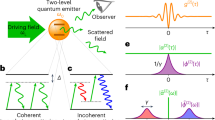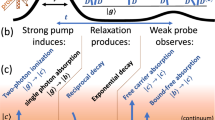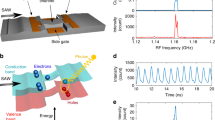Abstract
Two-photon emission is a process in which electron transition between quantum levels occurs through the simultaneous emission of two photons. This phenomenon is important for astrophysics and atomic physics1,2, and semiconductor two-photon emission was recently proposed as a compact source of entangled photons, essential for practical quantum information processing3,4,5, and three orders of magnitude more efficient6 than the existing down-conversion schemes. Two-photon absorption in semiconductors has been extensively investigated7,8,9,10,11; however, spontaneous semiconductor two-photon emission has not been observed, nor has it been fully analysed theoretically so far. We report the first experimental observations of two-photon emission from semiconductors and develop a corresponding theory. Spontaneous two-photon emission is demonstrated in optically pumped bulk GaAs and in electrically driven GaInP/AlGaInP quantum wells. Singly stimulated two-photon emission measurements demonstrate the theoretically predicted two-photon optical gain in semiconductors12,13,14,15—a necessary ingredient for any realizations of future two-photon semiconductor lasers. A photon-coincidence experiment is presented to validate the simultaneity of the electrically driven GaInP/AlGaInP two-photon emission, limited only by the detector's temporal resolution.
This is a preview of subscription content, access via your institution
Access options
Subscribe to this journal
Receive 12 print issues and online access
$209.00 per year
only $17.42 per issue
Buy this article
- Purchase on Springer Link
- Instant access to full article PDF
Prices may be subject to local taxes which are calculated during checkout




Similar content being viewed by others
References
Goldman, S. P. & Drake, G. W. F. Relativistic two-photon decay rates of 2s1/2 hydrogenic ions. Phys. Rev. A 24, 183–191 (1981).
Shapiro, J. & Breit, G. Metastability of 2s states of hydrogenic atoms. Phys. Rev. 113, 179–181 (1959).
Kumar, P. et al. Photonic technologies for quantum information processing. Quantum Inf. Process. 3, 215–231 (2004).
Walton, Z. D., Abouraddy, A. F., Sergienko, A. V., Saleh, B. E. A. & Teich, M. C. One-way entangled-photon autocompensating quantum cryptography. Phys. Rev. A 67, 062309 (2003).
Clauser, J. F., Horne, M. A., Shimony, A. & Holt, R. A. Proposed experiment to test local hidden-variable theories. Phys. Rev. Lett. 23, 880–884 (1969).
Hayat, A., Ginzburg, P. & Orenstein, M. High-rate entanglement source via two-photon emission from semiconductor quantum wells. Phys. Rev. B 76, 035339 (2007).
Nathan, V., Guenther, A. H. & Mitra, S. S. Review of multiphoton absorption in crystalline solids. J. Opt. Soc. Am. B 2, 294–316 (1985).
Lee, C. C. & Fan, H. Y. Two-photon absorption with exciton effect for degenerate valence bands. Phys. Rev. B 9, 3502–3516 (1974).
Basov, N. G. et al. Semiconductor lasers using optical pumping. J. Phys. Soc. Jpn 21, 277–282 (1966).
Hutchings, D. C. & Van Stryland, E. W. Nondegenerate two-photon absorption in zinc blende semiconductors. J. Opt. Soc. Am. B 9, 2065–2074 (1992).
Sheik-Bahae, M., Hutchings, D. C., Hagan, D. J. & Van Stryland, E. W. Dispersion of bound electron nonlinear refraction in solids. IEEE J. Quant. Electron. 27, 1296–1309 (1991).
Ironside, C. N. Two-photon gain semiconductor amplifier. IEEE J. Quant. Electron. 28, 842–847 (1992).
Ning, C. Z. Two-photon lasers based on intersubband transitions in semiconductor quantum wells. Phys. Rev. Lett. 93, 187403 (2004).
Marti, D. H., Dupertuis, M.-A. & Deveaud, B. Feasibility study for degenerate two-photon gain in a semiconductor microcavity. IEEE J. Quant. Electron. 39, 1066–1073 (2003).
Heatley, D. R., Firth, W. J. & Ironside, C. N. Ultrashort-pulse generation using two-photon gain. Opt. Lett. 18, 628–630 (1993).
Lipeles, M., Novick, R. & Tolk, N. Direct detection of two-photon emission from the metastable state of singly ionized helium. Phys. Rev. Lett. 15, 690–693 (1965).
Lange, W., Agarwal, G. S. & Walther, H. Observation of two-photon decay of Rydberg atoms in a driven cavity. Phys. Rev. Lett. 76, 3293–3296 (1997).
Ali, R. et al. Shape of the two-photon-continuum emission from the 1s2s1S0 state in He-like krypton. Phys. Rev. A 55, 994–1006 (1997).
Myles, C. W., Dow, J. D. & Sankey, O. F. Theory of alloy broadening of impurity electronic spectra. Phys. Rev. B 24, 1137–1139 (1981).
Pfister, O., Brown, W. J., Stenner, M. D. & Gauthier, D. J. Polarization instabilities in a two-photon laser. Phys. Rev. Lett. 86, 4512–4514 (2001).
Gauthier, D. J., Wu, Q., Morin, S. E. & Mossberg, T. W. Realization of a continuous-wave, two-photon optical laser. Phys. Rev. Lett. 68, 464–467 (1992).
Fainman, Y., Guest, C. C. & Lee, S. H. Optical digital logic operations by two-beam coupling in photorefractive material. Appl. Opt. 25, 1598–1603 (1986).
Goppert-Mayer, M. Űber Elementarakte mit zwei Quanenspruengen. Ann. Phys. 9, 273–294 (1931).
Boyd, R. W. Nonlinear Optics (Academic, New York, 1992).
Rosencher, E. & Bois, Ph. Model system for optical nonlinearities: Asymmetric quantum wells. Phys. Rev. B 44, 11315–11327 (1991).
Sipe, J. E. & Shkrebtii, A. I. Second-order optical response in semiconductors. Phys. Rev. B 61, 5337–5352 (2000).
Flatté, M. E., Young, P. M., Peng, L.-H. & Ehrenreich, H. Generalized superlattice K·p theory and intersubband optical transitions. Phys. Rev. B 53, 1963–1978 (1996).
Joyce, W. B. & Dixon, R. W. Analytic approximations for the Fermi energy of an ideal Fermi gas. Appl. Phys. Lett. 31, 354–356 (1977).
Kleinman, D. A. & Miller, R. C. Band-gap renormalization in semiconductor quantum wells containing carriers. Phys. Rev. B 32, 2266–2272 (1985).
Buller, G. S. et al. Semiconductor avalanche diode detectors for quantum cryptography. IEEE–LEOS Newsletter 20, 20–24 (2006).
Author information
Authors and Affiliations
Corresponding author
Rights and permissions
About this article
Cite this article
Hayat, A., Ginzburg, P. & Orenstein, M. Observation of two-photon emission from semiconductors. Nature Photon 2, 238–241 (2008). https://doi.org/10.1038/nphoton.2008.28
Received:
Accepted:
Published:
Issue Date:
DOI: https://doi.org/10.1038/nphoton.2008.28
This article is cited by
-
Controlling two-photon emission from superluminal and accelerating index perturbations
Nature Physics (2022)
-
Two-plasmon spontaneous emission from a nonlocal epsilon-near-zero material
Communications Physics (2021)
-
Ab initio electron-two-phonon scattering in GaAs from next-to-leading order perturbation theory
Nature Communications (2020)
-
Light–matter interactions with photonic quasiparticles
Nature Reviews Physics (2020)
-
Plasmon–emitter interactions at the nanoscale
Nature Communications (2020)



